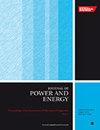涡轮增压器径向流压缩机从喷涌到堵塞的熵产生率分析
IF 1.1
4区 工程技术
Q3 ENGINEERING, MECHANICAL
Proceedings of the Institution of Mechanical Engineers, Part A: Journal of Power and Energy
Pub Date : 2023-11-18
DOI:10.1177/09576509231216187
引用次数: 0
摘要
考虑到冲击现象、边界层分离和混合机制,本研究比较了径向压缩机从激增到阻塞范围内的局部损失。为此,在计算流体动力学(CFD)求解器中加入了局部熵生成率(EGR)的计算,该求解器通过 RANS 方法对压缩机的湍流场进行建模。为进行验证,将压缩机的数值压力上升曲线与实验数据进行了比较。结果表明,在设计点,叶轮、扩散器和涡道分别占 EGR 的约 50.8%、30.0% 和 12.3%,其中叶轮背隙约占 5%,扩散器腔约占 1%,入口管道不到 0.5%。接近涌流工况时,混合和冲击波造成的局部损失会下降,而边界层损失会增加。根据对前缘边界层的综合分析,在设计点发现了最大的死气区,从而导致较低的扩散入口损失和较高的混合损失。此外,还研究了扩散器通道中的 EGR 变化,揭示了混合动力学,并根据混合比 (MR) 将通道流态划分为三个不同区域。研究结果表明,在混合比(MR)较高的情况下,流态的混合速度更快,从而导致 EGR 略有下降,有利于压缩机性能的提高。我们证明,在接近涌流边缘的前缘边界层和径向扩散器中,流态的混合率都会降低。本文章由计算机程序翻译,如有差异,请以英文原文为准。
Entropy generation rate analysis of turbocharger radial flow compressor in range from surge to choke
This study compares the local losses of a radial compressor in the range from surge to choke considering shock phenomena, boundary layer separation, and mixing mechanisms. For this purpose, formulation of the local entropy generation rate (EGR) is added to the computational fluid dynamics (CFD) solver, which models the turbulent flow field of the compressor through the RANS approach. For validation, the numerical pressure rise curve of the compressor is compared with the experimental data. The results indicate that at the design point, the impeller, diffuser, and the volute account for approximately 50.8%, 30.0%, and 12.3% of the EGR, respectively, with approximately 5% in the impeller backspace, 1% in the diffuser cavity, and less than 0.5% in the inlet duct. Approaching the surge condition, local losses due to mixing and shock waves decline while boundary layer losses increase. Based on comprehensive analysis of the leading-edge boundary layer, the largest dead-air zone is found at the design point, resulting in a lower diffusion entrance loss and a higher mixing loss. Furthermore, the EGR variation in the diffuser channel is investigated by shedding light on mixing dynamics and classification of the channel flow regime into three different zones based on mixing ratio (MR). The outcomes show that the flow regime tends to mix more quickly at a higher MR, resulting in a slight decrease in EGR, which benefits compressor performance. We demonstrate that the mixing rate of flow regimes decreases in both the leading-edge boundary layer and the radial diffuser approaching the surge margin.
求助全文
通过发布文献求助,成功后即可免费获取论文全文。
去求助
来源期刊

CiteScore
3.30
自引率
5.90%
发文量
114
审稿时长
5.4 months
期刊介绍:
The Journal of Power and Energy, Part A of the Proceedings of the Institution of Mechanical Engineers, is dedicated to publishing peer-reviewed papers of high scientific quality on all aspects of the technology of energy conversion systems.
 求助内容:
求助内容: 应助结果提醒方式:
应助结果提醒方式:


